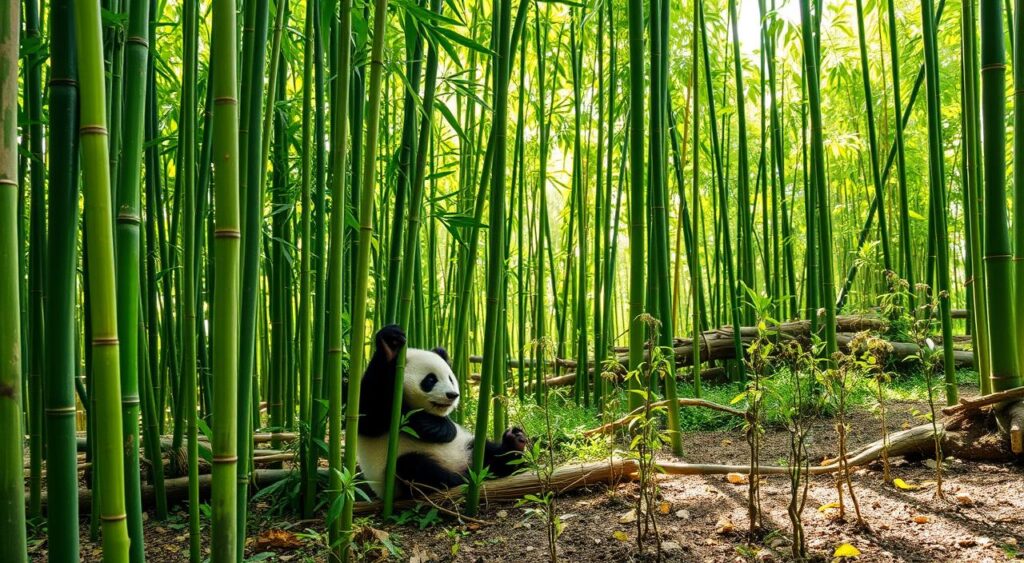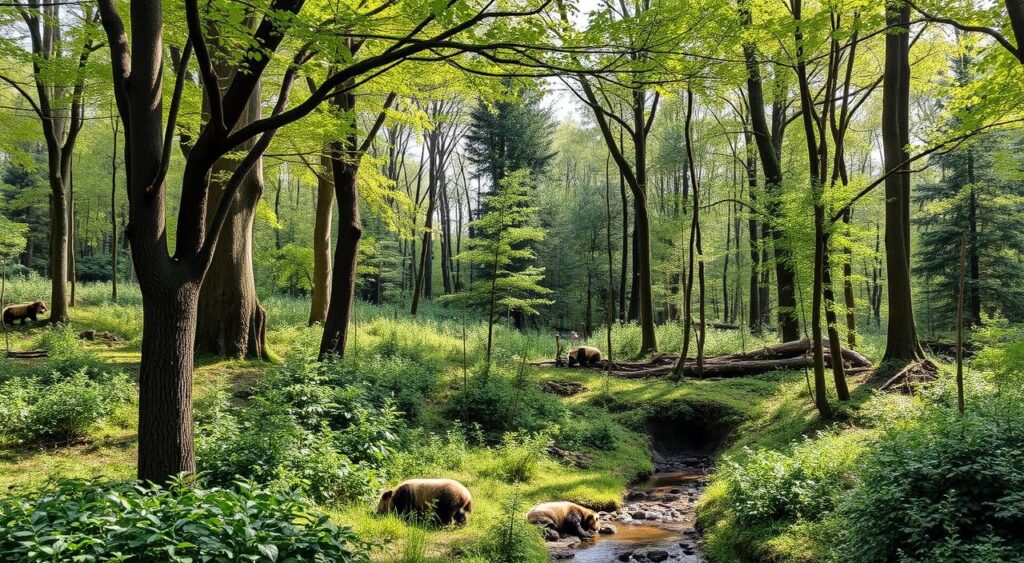The giant panda, a symbol of conservation, has faced habitat loss and fragmentation. But, the Chinese government and international groups have worked hard to protect their homes. They’ve created panda reserves and started reforestation projects. This has helped the panda population grow, moving from “Endangered” to “Vulnerable” in 2016.
But, the fight to save the giant panda is not over. They still face threats like habitat loss and climate change affecting their bamboo food. Reforestation, forest management, and climate change mitigation are key to their survival and the ecosystems they live in.
Key Takeaways
- Reforestation efforts have played a crucial role in increasing the forest area occupied by giant pandas in China, leading to an 11.8% increase in panda habitat.
- Conservation initiatives, such as the China-World Bank-GEF Nature Reserve Management Project, have introduced science-based monitoring, management planning, and community engagement to enhance panda habitats.
- Restoring degraded forests and creating contiguous panda habitats are essential for ensuring the long-term survival and population recovery of the giant panda.
- Sustainable forest management practices, including the shift from unsustainable logging to forest conservation, are crucial for maintaining healthy and resilient panda habitats.
- Addressing the impacts of climate change on bamboo availability and other threats to panda populations requires a multifaceted approach that includes reforestation and habitat restoration efforts.
Reforestation Efforts in China: A Key Factor in Panda Conservation
China leads the world in population and greenhouse gas emissions. It focuses a lot on reforestation and forest conservation. This is especially true in areas where the giant panda lives. These efforts are key to keeping the panda’s home safe.
China’s National Reforestation Programs and Policies
In the last 20 years, China has started big reforestation programs. The Grain-for-Green Program, started in 1999, turned over 69.2 million acres of land back into forests. It’s one of the biggest efforts to reforest the world.
But, most of these new forests are single-type plantations. This can harm the natural forests that were there before.
Still, the tree cover in southwestern China, where pandas live, grew by 32% from 2000 to 2015. This growth came from government help and the chance for local people to make money from trees. Yet, the government’s help doesn’t tell the difference between natural forests and plantations. This can lead to natural forests being replaced by new ones.
Restoring Panda Habitats Through Forest Recovery
The Chinese government is working hard to protect and restore panda habitats. From 2001 to 2012, about 157,000 hectares of tree cover were lost in panda habitats. This shows how important it is to keep working on conservation.
Researchers suggest starting an eco-compensation program. This could help protect pandas and their homes while also helping local economies.
A one-time payment of about $1.3 billion could help save panda habitats. Spending $3.7 billion could even increase panda numbers by 40%. This shows how big of a difference well-planned reforestation can make for the panda.
The Giant Panda: An Iconic Species and Biodiversity Ambassador

The giant panda is loved worldwide for its black-and-white fur and gentle nature. It lives in the mountains of central China, in Sichuan, Shaanxi, and Gansu provinces. This animal is more than cute; it’s a symbol of wildlife conservation.
In Chinese culture, pandas represent peace and friendship. They are often given as gifts, known as “panda diplomacy.” The giant panda’s global fame makes it a key symbol for wildlife conservation, with the World Wildlife Fund using it since 1961.
Despite being endangered, the giant panda population has grown thanks to China’s reforestation efforts and conservation. This species is a biodiversity ambassador, highlighting the need to protect and restore forests for all wildlife.
“The giant panda is not just an icon of cuteness, but a symbol of our collective responsibility to protect the natural world. Its survival is a testament to the power of coordinated conservation efforts.”
As we battle climate change and deforestation, the panda’s story is crucial. It shows the importance of reforestation and sustainable forest management for our planet’s health.
Challenges Facing Panda Conservation

Despite recent successes, pandas still face big challenges. One major threat is habitat loss and fragmentation due to human activities. These include farming, mining, and building projects in panda habitats.
The World Wildlife Fund (WWF) reports a 58% decline in species populations from 1970 to 2012. This is based on 14,152 monitored populations of 3,706 vertebrate species. If nothing changes, this decline could reach 67% by 2020.
Habitat Loss and Fragmentation
The Chinese government’s new forest reforms are a big challenge. They transferred 24% of forest ownership to residents in Sichuan Province. If the compensation for conservation is less than the benefits of forest exploitation, people might cut down trees. This could harm the panda’s survival.
Climate Change and Bamboo Availability
Climate change also affects pandas’ food, bamboo. Pandas eat up to 40 pounds of bamboo daily. Climate change could make finding enough bamboo harder, threatening their survival.
The International Union for Conservation of Nature (IUCN) lowered the panda’s status from “endangered” to “vulnerable” in 2016. But some say they should still be considered endangered. This is because of habitat loss, low population connectivity, and the need for more protection.
The Impact of Reforestation on Panda Populations

The Chinese government’s efforts have boosted giant panda numbers. They focused on saving biodiversity, creating nature reserves, and investing more money. These steps have cut down on habitat damage. Reforestation projects are key in fixing panda homes and growing their food, bamboo.
Increased Habitat Range and Connectivity
Reforestation has helped pandas by growing their living space. Projects like protecting natural forests and restoring farmland have increased panda habitats by 11.8%. This also made more forests available for pandas to explore, giving them better access to food and shelter.
Improved Food Sources and Bamboo Growth
Bamboo, pandas’ main food, has grown thanks to reforestation. Pandas eat a lot, up to 40 pounds of bamboo daily. This abundance of bamboo has helped pandas thrive.
More space, better connections, and plenty of food are key to saving pandas. They are a symbol of the need for reforestation to keep ecosystems healthy and protect endangered species.
Reforestation and Sustainable Forest Management

Reforestation is key to balancing human needs with nature. It involves controlling invasive species and maintaining tree diversity. Techniques like controlled burns also help keep forests healthy.
In places like California, managing fires and thinning trees is crucial. This ensures the forest’s long-term health.
Reforestation often means planting seedlings after fires or land clearing. Groups like American Forests help by growing seedlings and choosing the right tree species. But, natural growth is also important, where forests grow back from seeds and surviving trees.
Climate change makes natural growth less reliable, covering only 40% of reforestation needs. So, foresters must plant the other 60% to restore forests. Deforestation is a big problem, with 10 million hectares lost each year from 2015 to 2020.
It’s important to respect Indigenous Peoples’ rights. Studies show they can cut tree felling by about one-fifth. Forest managers must balance human needs with forest health and biodiversity.
A good forest management plan is essential. It helps protect the forest’s health and resilience for the long term.
In summary, reforestation and sustainable forest management are crucial for our planet. By using natural growth, planting trees, protecting Indigenous rights, and having good plans, we can ensure a sustainable future for our forests.
The Cultural Significance of Pandas and Conservation Efforts

Pandas are more than just animals; they are symbols of peace and friendship in Chinese culture. Their image is everywhere in Chinese art, literature, and media. This shows the nation’s pride and dedication to saving wildlife.
The panda’s global fame makes it a key figure in conservation worldwide. It helps spread the word about protecting our planet.
Pandas as Symbols of Peace and Conservation
“Panda diplomacy” is a tradition where China gives pandas to other countries as gifts. This highlights the panda’s importance in Chinese culture. The World Wildlife Fund (WWF) also uses the panda as its logo since 1961. It helps bring attention to global conservation.
The panda’s story brings attention to endangered species and their homes. By 2020, only about 2,000 pandas were left in the wild. Saving them is key.
Thanks to conservation, pandas are now considered “vulnerable” instead of “endangered.” This shows how effective these efforts have been.
“Preserving the panda’s natural habitat aids 70% of the country’s forest birds, 70% of mammals, and 31% of amphibians,” according to a scientific paper published in 2015 by The Society for Conservation Biology.
The panda also helps local communities through ecotourism. This creates jobs and supports conservation. It shows the value of protecting pandas and their homes.
The panda is a symbol of China’s natural heritage and a global conservation icon. It inspires efforts to restore forests and protect biodiversity worldwide.
Also Read: Why Protecting Pandas is Essential for Global Biodiversity
Conclusion
The giant panda’s story shows how reforestation can change things. These animals still face big challenges. But, the success of conservation efforts, like fixing forest homes, is a lesson for saving other endangered species.
Dealing with climate change makes reforestation and forestry even more crucial. By planting trees, we help animals and fight carbon dioxide. This also cuts down on greenhouse gas emissions and stops deforestation harm. The giant panda’s survival shows us the strength of working together to protect our planet.
The reforestation efforts we’ve talked about offer a path forward. Using interdisciplinary frameworks and the newest science, we can tackle big environmental issues. By working together, we can bring back forest cover and help endangered animals. The giant panda’s success story encourages us to act boldly for a greener future.
FAQs
Q: How does reforestation contribute to climate mitigation?
A: Reforestation plays a crucial role in climate mitigation by increasing forest cover, which enhances carbon sequestration. By planting new trees, we can absorb significant amounts of carbon dioxide from the atmosphere, helping to mitigate the effects of climate change.
Q: What is the importance of reforestation in preventing deforestation?
A: Reforestation is essential in preventing deforestation as it helps restore lost ecosystems, enhances biodiversity, and provides a habitat for wildlife. By addressing reforestation, we can combat the ongoing loss of forest cover and its associated environmental impacts.
Q: How can reforestation help with wildfire mitigation?
A: Reforestation can help with wildfire mitigation by promoting healthy forests that are better managed and more resilient to fires. By restoring forest cover and implementing appropriate land management practices, we can reduce the risk and severity of wildfires.
Q: What are the benefits of reforestation for panda conservation?
A: Reforestation provides essential benefits for panda conservation by restoring their natural habitat. Increased forest cover improves the availability of bamboo, which is the primary food source for pandas, thus supporting their population and ensuring their survival.
Q: What is the expected impact of the reforestation strategy in the United States?
A: The reforestation strategy in the United States aims to restore forest cover for climate mitigation and biodiversity enhancement. With an opportunity to restore 148 million acres of forest cover, this strategy will have significant benefits for carbon sequestration, wildlife habitats, and ecosystem health.
Q: How does the US Forest Service contribute to reforestation work?
A: The US Forest Service actively engages in reforestation work by managing public land, implementing tree planting initiatives, and supporting research on the right species for restoration. Their efforts are vital in addressing soil erosion and enhancing overall forest health.
Q: What is a reforestation hub and its role in conservation?
A: A reforestation hub is a designated area that focuses on large-scale tree planting and forest restoration efforts. These hubs play a significant role in coordinating reforestation pipelines, providing seed sources, and ensuring the successful regeneration of healthy forests.
Q: How can the planting of trees contribute to carbon sequestration?
A: The planting of trees contributes to carbon sequestration by capturing and storing carbon dioxide from the atmosphere. Each tonne of carbon stored by new trees helps to reduce emissions and combat climate change, making tree planting a vital aspect of reforestation efforts.
Q: What challenges do we face in achieving successful reforestation?
A: Challenges in achieving successful reforestation include selecting the right species, ensuring adequate seed sources, managing soil health, and addressing potential threats like wildfires and invasive species. Overcoming these challenges is essential for effective forest restoration and long-term sustainability.

